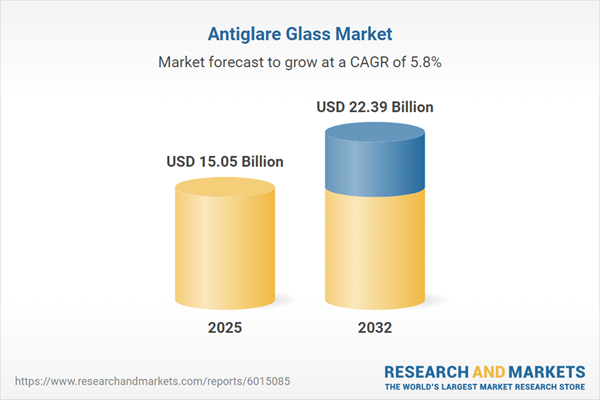Speak directly to the analyst to clarify any post sales queries you may have.
The antiglare glass market is seeing accelerated uptake as enterprises across key sectors focus on operational performance, workplace visibility, and modern infrastructure resilience. Shifts in digital complexity and demanding environments are fueling robust demand for innovative antiglare solutions that support sustainable growth and efficiency.
Market Snapshot: Antiglare Glass Market Size and Growth
The global antiglare glass market is valued at USD 14.23 billion in 2024 and is projected to reach USD 15.05 billion in 2025, reflecting a 5.82% CAGR. This growth is driven by widespread adoption in electronics, architecture, automotive, aerospace, and solar energy. Market leaders are innovating with advanced glare-reduction technologies and are focusing on optimizing supply chains and product portfolios. These directions allow for more responsive go-to-market strategies and ongoing product evolution, helping companies adapt as demands shift. The intersection of strategic development and supply resilience is reshaping the market's competitive landscape and expanding opportunities for organizations deploying antiglare glass globally.
Scope & Segmentation: Antiglare Glass Across Industries
This report is tailored for senior leaders needing actionable insights to guide investment prioritization and resource planning. The layered segmentation is designed to reflect operational and procurement cycles, enabling effective strategy, risk oversight, and implementation across multiple geographies and sectors.
- Applications: Covers aerospace (military and commercial fleets), architectural settings (residential and commercial projects), automotive uses (consumer vehicles and fleet contexts), consumer electronics (phones, laptops, televisions, and tablets), and solar systems (thermal and photovoltaic installations). Each segment reflects unique performance and compliance requirements, emphasizing tailored design and supply strategies.
- Product Types: Includes chemical strengthened glass, laminated glass, nano-coated glass, and tempered glass. These types serve varied consumer, business, and industrial needs, supporting project customization for function and durability.
- Coating Technologies: Encompasses chemical etching, ion exchange, and nano coating methods. Such technologies enhance operational durability, optical performance, and resilience in demanding conditions, addressing requirements in sectors such as transport and critical infrastructure.
- Distribution Channels: Involves direct sales to end users, distributor networks, and online procurement platforms. This structure ensures flexible and responsive sourcing for organizations adapting to market shifts.
- Thickness Options: Provides choices below 2 mm, between 2–5 mm, and above 5 mm, supporting specificity for electronics manufacturing or structural projects across segments.
- Regional Coverage: Addresses Americas, Europe, Middle East & Africa, and Asia-Pacific. Insights include regional regulatory dynamics and focused market parameters for the United States, Germany, China, and India.
- Leading Companies: Highlights Asahi Glass Co., Ltd., Nippon Sheet Glass Co., Ltd., Corning Incorporated, Guardian Industries Corp., Nippon Electric Glass Co., Ltd., PPG Industries, Inc., Hoya Corporation, and Xinyi Glass Holdings Limited, all of which drive technology advancements and capacity investment worldwide.
Key Takeaways: Strategic Insights for Senior Decision-Makers
- Leadership in antiglare visual solutions enables organizations to maintain productivity and consistent operational performance in digitally demanding environments.
- Continuous innovations such as nano-based coatings and chemical etching drive adoption in infrastructure upgrades, as well as in next-generation transportation and electronics platforms.
- Efficient manufacturing enabled by automation and modular design strengthens quality control and helps enterprises align with evolving regulatory standards efficiently.
- Supply chain digitization and resilient procurement frameworks support organizations in navigating volatile market conditions and procurement uncertainties.
- Sustainability is increasingly central in antiglare glass product development, reflecting higher demand for responsible sourcing and green compliance, especially in public infrastructure and mobility sectors.
- Collaborative R&D initiatives and partnerships across industries foster rapid deployment of antiglare glass solutions for settings with complex operational requirements.
Tariff Impact: Navigating Trade and Sourcing Challenges
Recent increases in US tariffs have led to higher costs for imported laminated and specialty-coated glass products in the antiglare glass supply chain. In response, management teams are turning toward regional sourcing strategies and building local technology partnerships. These measures support greater procurement flexibility, maintain operational continuity, and protect organizational priorities despite shifting trade conditions.
Methodology & Data Sources
The analysis is grounded in direct interviews with supply chain experts and market analysts, verified against published industry reports and regulatory documentation. Insights are rigorously validated for relevance and reliability for senior leadership.
Why This Report Matters
- Empowers business leaders to identify the most promising growth avenues and strategically align investments with sector trends.
- Clarifies emerging regulatory challenges and streamlines procurement risk assessment for effective and prompt executive action.
- Supports integration of advanced antiglare technologies, strengthening compliance and sustaining operational excellence across regions.
Conclusion
Ongoing innovation, compliance demands, and collaborative industry relationships are shaping the future direction of the antiglare glass sector. This research equips decision-makers to anticipate emerging trends and align responsive business strategies accordingly.
Additional Product Information:
- Purchase of this report includes 1 year online access with quarterly updates.
- This report can be updated on request. Please contact our Customer Experience team using the Ask a Question widget on our website.
Table of Contents
3. Executive Summary
4. Market Overview
7. Cumulative Impact of Artificial Intelligence 2025
Companies Mentioned
The companies profiled in this Antiglare Glass market report include:- Asahi Glass Co., Ltd.
- Nippon Sheet Glass Co., Ltd.
- Corning Incorporated
- Guardian Industries Corp.
- Nippon Electric Glass Co., Ltd.
- PPG Industries, Inc.
- Hoya Corporation
- Xinyi Glass Holdings Limited
Table Information
| Report Attribute | Details |
|---|---|
| No. of Pages | 187 |
| Published | November 2025 |
| Forecast Period | 2025 - 2032 |
| Estimated Market Value ( USD | $ 15.05 Billion |
| Forecasted Market Value ( USD | $ 22.39 Billion |
| Compound Annual Growth Rate | 5.8% |
| Regions Covered | Global |
| No. of Companies Mentioned | 9 |









